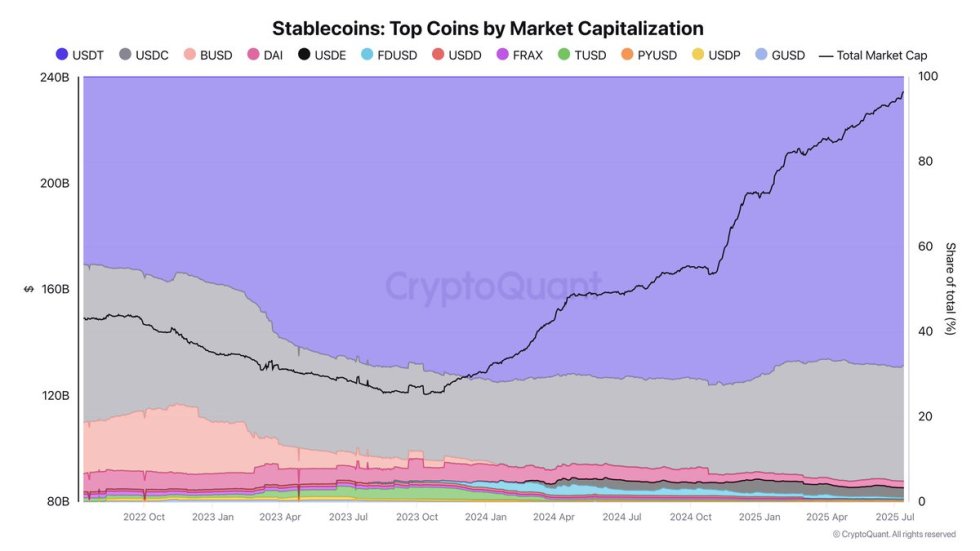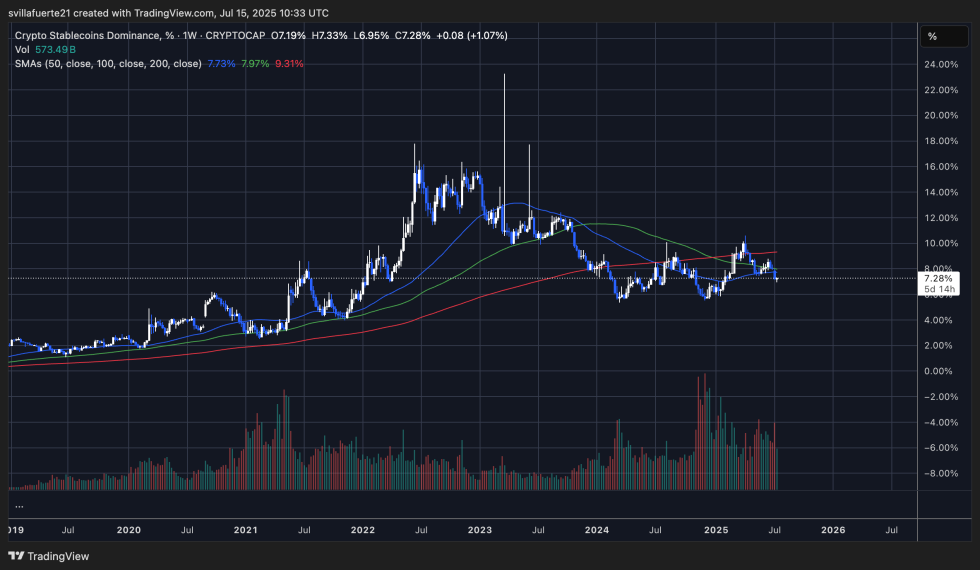
Stablecoins have emerged as the fastest-growing sector in the crypto market since the beginning of this cycle, playing a critical role in driving liquidity, market stability, and cross-border transactions. Their explosive growth has now placed them at the center of regulatory discussions, especially during this week’s highly anticipated “Crypto Week” in Washington.
US lawmakers are currently reviewing the Genius Act, a pivotal bill aimed at defining the legal framework for stablecoins in the United States. The outcome of this legislation could shape how dollar-backed digital assets are issued, regulated, and integrated into the broader financial system—impacting institutions, developers, and investors alike.
Meanwhile, market data from CryptoQuant shows that Tether (USDT) continues to dominate the stablecoin landscape, commanding 68% of the market share. USD Coin (USDC) follows with 27%, while newer entrants like USDE hold 2.2%. Binance’s BUSD now trails at just 1.5%, reflecting its gradual phase-out.
Stablecoins Fuel Market Liquidity
Top analyst Darkfost has highlighted a critical development in the crypto market: the total market cap of stablecoins has now climbed to $235 billion. This steady increase is more than just a number—it’s a clear signal that liquidity continues to flow into the digital asset space, even as prices experience short-term volatility. The rising stablecoin supply suggests that capital is being parked on-chain, ready to deploy across trading, DeFi, and institutional strategies.

Stablecoins have become the primary liquidity engine behind Bitcoin and the broader crypto market. Their utility as dollar-pegged, low-volatility assets makes them ideal for trading, hedging, and transferring value without relying on traditional banks. In essence, they are the bridge between traditional finance and crypto—connecting centralized capital with decentralized infrastructure.
With “Crypto Week” underway in Washington, stablecoins are under the spotlight. US legislators are expected to make critical decisions that could shape the way these assets function within both the crypto space and the traditional financial system. If regulators move toward supportive and well-defined guidelines, adoption and issuance could accelerate rapidly.
Analysts expect that legal clarity around stablecoins will not only boost investor confidence but also open the door for more institutional participation. Given their central role in liquidity flows, any positive outcome from this week’s debates could fuel the next wave of capital entering crypto markets—solidifying stablecoins as essential infrastructure for the digital economy. As liquidity builds, the groundwork for a broader market expansion continues to strengthen.
Dominance Holds at 7.28% as Market Liquidity Builds
The weekly chart of stablecoin dominance shows that they currently account for 7.28% of the total crypto market, a level that has held relatively steady in recent months. Despite the recent surge in total market cap to $235 billion, dominance has remained within a sideways range, suggesting that liquidity is flowing into both stablecoins and crypto assets simultaneously—rather than moving defensively into stables as seen during previous bear cycles.

Notably, the chart shows dominance falling below all major moving averages: the 50-week (7.73%), 100-week (7.97%), and 200-week (9.31%) SMAs. This suggests that while stablecoin issuance is rising in absolute terms, its share of total market value is shrinking as Bitcoin and altcoins outperform. This is typically seen during early to mid-stage bull markets, when capital begins rotating from stablecoins into risk-on assets.
Historically, sharp spikes in dominance have coincided with periods of market stress, while declines have marked expansion phases. The current stability around 7% reflects a balanced environment where liquidity remains available, but market participants are comfortable holding volatile assets.
Featured image from Dall-E, chart from TradingView

Editorial Process for bitcoinist is centered on delivering thoroughly researched, accurate, and unbiased content. We uphold strict sourcing standards, and each page undergoes diligent review by our team of top technology experts and seasoned editors. This process ensures the integrity, relevance, and value of our content for our readers.

